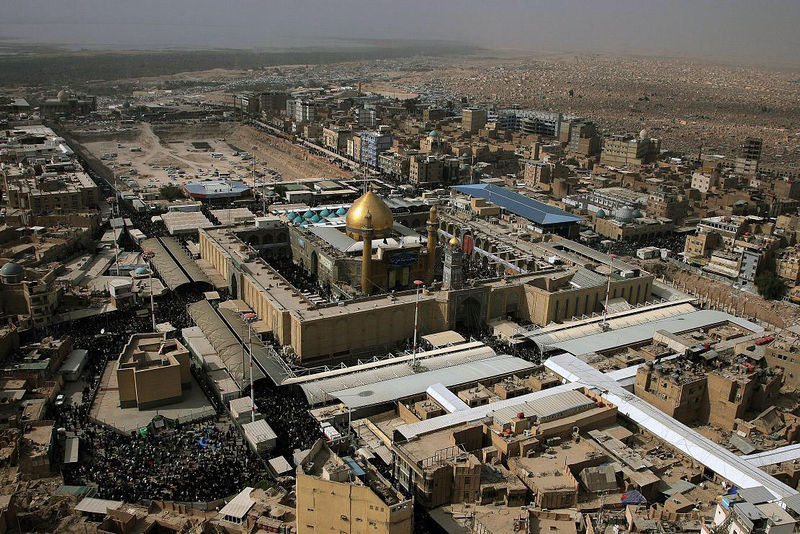DEFINITION OF THE CITY:
Najaf is one of the sacred cities of Iraq, the Door of the Greatest Prophet's Knowledge (may the blessing and peace of Allah be upon him and his pure progeny), the capital of his jurisprudence, sciences of the pure Progeny. It is also a burial ground of the son of the Ka'aba, the Martyr of Mihrab, Commander of the Faithful, Imam Ali (peace be upon him), it is also a source of (marjaiyyah) authority and (taqlid) acting according to that authority, a cradle of scientific and literary movements, mother of sciences, piety, poetry, and (jihad) holy war.

THE LOCATION OF THE CITY:
Najaf is located on the edge of the western plateau of Iraq, at southwest of Baghdad the capital city of Iraq, with 160 km far from the capital. It is almost 70 meters above sea level, and is situated on the longitude of 19 degrees and 44 minutes, as well as on the latitude of 31 degrees and 59 minutes. This city is boarded from north and northwest by Karbalaa city (which is 80 km far from the city), and from the south and west by the sea of Najaf, and Abu Sukhair (which is 18 km far from the city) and from the east by Kufah city (which is 10 km far from the city).
FOUNDATION :
Indeed, nowadays Najaf is the same Najaf Al-Kufah (differing from Najaf Al-Hairah). It is also an Arabian town as well as a summer resort in ancient time for Al-Manaazirah (kings of Al-Hairah). They do spread the Christian monasteries in the city before the Islamic conquer, but the city changed and became a big city, its range was expanded and its inhabitants became crowded, this is because of the existence of Imam Ali's holy shrine (peace be upon him) which gave the city a mark of holiness and respect. The city then became a center of religious leadership along with a resort of scientific figures. Najaf is an Arabic name, which has been derived from (Al-Manjuf), its plural is Najaaf (means a place where water can not overtop), because it is a highland similar to a hill which it use to block or prevent water to things close to it. Also the word Najaf is refer to a hill. Najaf was given various names which some of them came in tradition of Ahlulbait (peace be upon them), some of those names were circulated by them, such as: Baanqiya, Al-Judi, Ar-Rabwah, Zahrul Kufah, Al-Gharbi, Al-Lisaan, At-Tur. Of them are common use like Najaf, Al-Ghar'yi, and Mashhad. It was reported that Najaf was a great mountain which son of Noah said about said: (I will betake myself for refuge to a mountain that shall protect me from the water) but the mountain broke into pieces and became sand by the Will of Allah. The name of that sea was (Niy) and later on became (Niy jaf) then changed to Najaf, because of smoothness of pronunciation.
THE EXPANSION AND CONSTRUCTION:
In year 170 A.H. After the appearance of Commander of Faithful Imam Ali's holy shrine (peace be upon him), Najaf became a city with a big number of buildings, as the constructional work of the city continued gradually until it became a well developed city. Constructional works of Najaf is divided into 3 stages:
FIRST: Construction stage of the Buwaihi State which extended from year 338 A.H. until 9th century of Hijri, and he represents a prosperity vigor of Najaf whereas he built a first fence surrounded the city, then Abu Muhammed bin Sahlaan Alwazir Al-Buwaihi built the second fence in year 400 A.H.
SECOND: This stage which occurred between 9th century A.H. until the middle of 13th century A.H. in this period the buildings of the city became old and its brilliance disappeared, due to the war between Turks and Persians.
THIRD: This is the last stage which began from the middle of the 13th century A.H. when splendour and promotion returned to the city. Meanwhile, many constructional, cultural, and service changes occurred after the district became subsidiary to the Kar'bala province.
- Between year 550 A.H.- 656 A.H. Abbasid Caliph An-Naasir Li Deenillah, paid a great attention to the city. The construction work included repairing of Imam Ali's holy shrine (peace be upon him).
Sadrul A'zam Nizamu Dawlah Muhammed Husain Al-Alaf (vazir of Fat'h Ali Shah Al-Qajari)commanded that the biggest and strongest fence should be built around the city after several attacks occurred on the sanctuaries by Wahhabis from Najd. This incident took place in the year 1227 A.H. / 1810 A.D.
- At the end of the 7th and 8th centuries A.H., and during the time of Al-Ilkhaniyah and Al-Jala'iriyah kings in Iraq, Najaf observed a big constructional progress and became crowded for the inhabitants, as a scientific schools were also constructed.
ـ The domestic Company founded a railway in year 1325 A.H. which connected the city with Kufah.
- In year (1325 A.H. / 1908 A.D.) A Railway was set up by a national company which connects between Najaf and Kufah.
- In year 1348 A.H. / 1929 A.D. Najaf connected to the Kufah by water pipes, as pumps were also installed to push water to it. While before the city was depending on canal wells and small rivers to take its water from Furat River which is far from the city.
- In year 1350 A.H. / 1931 A.D. during the period of the successor Sayyid Jafar Hamandi, the regional government opened five doors in the city fence and planned for a wide square in the southern part of the city, then the merchants and inhabitants of the city began to build palaces, houses, coffeehouses, gardens, and shops.
- The city Emirs established various schools, gardens, and parks, and a wide hospital. This new district was called (Al-Ghaziyah ) which was derived from the name of the king Ghazi.
- Railway was taken away in the year 1948 A.H. When it became easier for the cars to carry people between Najaf and Kufah as the road is made between them.
Source: imamali-a.com

